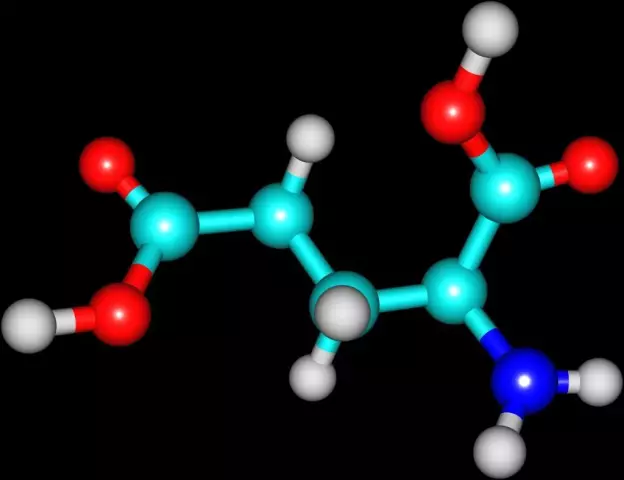- Author Rachel Wainwright [email protected].
- Public 2023-12-15 07:39.
- Last modified 2025-11-02 20:14.
Hopantenic acid
Hopantenic acid: instructions for use and reviews
- 1. Release form and composition
- 2. Pharmacological properties
- 3. Indications for use
- 4. Contraindications
- 5. Method of application and dosage
- 6. Side effects
- 7. Overdose
- 8. Special instructions
- 9. Application during pregnancy and lactation
- 10. Use in childhood
- 11. In case of impaired renal function
- 12. Drug interactions
- 13. Analogs
- 14. Terms and conditions of storage
- 15. Terms of dispensing from pharmacies
- 16. Reviews
- 17. Price in pharmacies
Latin name: Gopantenic acid
ATX code: N06BX
Active ingredient: hopantenic acid (Hopantenic acid)
Manufacturer: OZON, LLC (Russia)
Description and photo update: 2019-10-07
Prices in pharmacies: from 343 rubles.
Buy

Hopantenic acid is a nootropic agent.
Release form and composition
Dosage form - tablets: round, flat-cylindrical, from almost white to white, with a line and a chamfer (10, 20, 25, 30, 50 or 100 pcs. In PET / polypropylene cans, in a cardboard box 1 can; 10, 20, 25 or 30 pieces in blisters, in a cardboard box 1-5 or 10 packs and instructions for use of Hopantenic acid).
Composition of 1 tablet:
- active substance: calcium hopantenate - 250 or 500 mg;
- additional components (250/500 mg): magnesium hydroxycarbonate - 46.80 / 93.6 mg; povidone-K25 - 10.1 / 20.2 mg; calcium stearate - 3.1 / 6.2 mg.
Pharmacological properties
Pharmacodynamics
The spectrum of action of calcium hopantenate, the active substance of hopantenic acid, is associated with the presence of GABA (gamma-aminobutyric acid) in its structure and is due to the direct effect of calcium hopantenate on the GABA B -receptor-channel complex.
The substance has a nootropic and anticonvulsant effect, combines a mild stimulating effect with a moderate sedative effect. Other effects of the drug:
- increasing the resistance of the brain to hypoxia and exposure to toxic substances;
- stimulation of anabolic processes in neurons;
- decreased motor excitability;
- increasing mental and physical performance;
- improvement of GABA metabolism in patients with chronic alcohol intoxication and after ethanol withdrawal.
The substance is capable of inhibiting acetylation reactions, which are involved in the mechanisms of inactivation of novocaine (procaine) and sulfonamides, due to which the latter's action is prolonged. The use of hopantenic acid leads to inhibition of the pathologically increased gallbladder reflex and detrusor tone.
Pharmacokinetics
Calcium hopantenate is rapidly absorbed from the gastrointestinal tract after oral administration. The substance penetrates the blood-brain barrier, the creation of the highest concentrations occurs in the kidneys, liver, skin and stomach wall.
It is not metabolized in the body, excretion is carried out unchanged within 48 hours after ingestion: by the kidneys - 67.5%, through the intestines - 28.5%.
Indications for use
- cognitive impairment against the background of organic brain lesions, including with the consequences of craniocerebral trauma, neuroinfections and neurotic disorders;
- extrapyramidal hyperkinesis against the background of hereditary diseases of the nervous system: in combination with ongoing therapy;
- adverse events of neuroleptics (as a corrector), neuroleptic extrapyramidal syndrome (hyperkinetic and akinetic), cerebral organic insufficiency in patients with schizophrenia: as part of complex therapy;
- epilepsy in combination with mental retardation: in combination with anticonvulsants;
- decrease in physical and mental performance, psycho-emotional overload, use to improve concentration of memorization and attention;
- disorders of urination of neurogenic etiology, including pollakiuria, urgency, enuresis, urge incontinence;
- developmental delay (speech, mental, motor, or a combination thereof) in children, including after a previous perinatal encephalopathy, as well as in children with various forms of cerebral palsy;
- neurosis-like conditions (tics, stuttering, mainly in the clonic form) in children;
- hyperkinetic disorders (attention deficit hyperactivity disorder) in children.
Contraindications
Absolute:
- acute severe kidney disease;
- pregnancy and the period of breastfeeding;
- age up to 3 years;
- hypersensitivity to the components of the drug.
Hopantenic acid, instructions for use: method and dosage
Hopantenic acid is taken orally, 15-30 minutes after a meal, preferably in the morning and afternoon (no later than 17 hours).
Recommended doses:
- children from 3 to 18 years old - one-time - 250-500 mg; daily - 750-3000 mg;
- adult patients - single - 250-1000 mg; daily - 1500-3000 mg.
Duration of treatment is 1-4 months, in some cases - up to 6 months. Reapplication is possible in 3-6 months.
Recommended dosage regimen of Hopantenic acid:
- cognitive impairment in organic brain lesions: 3-4 times a day, 250 mg;
- extrapyramidal hyperkinesis in patients with hereditary diseases of the nervous system: in a daily dose of 500-3000 mg for a course of up to 4 months or more;
- adverse events of neuroleptics (as a corrector), neuroleptic extrapyramidal syndrome (hyperkinetic and akinetic), cerebral organic failure in patients with schizophrenia: adults - 3 times a day, 500-1000 mg, children - 3-4 times a day, 250-500 mg, duration of admission - from 1 to 3 months;
- epilepsy in combination with a slowdown in mental processes: adults - 3 times a day, 500-1000 mg, children - 3-4 times a day, 250-500 mg, duration of admission - from 6 months;
- decrease in physical and mental performance, psychoemotional overload, use to improve the concentration of memorization and attention: 3 times a day, 250 mg;
- disorders of urination of neurogenic etiology: adults - 2-3 times a day, 500-1000 mg, children - 3 times a day, 250-500 mg (daily dose - 25-50 mg / kg), duration of admission - from 1 to 3 months;
- neurosis-like states (tics, stuttering, mainly in the clonic form) in children: 3-6 times a day, 250-500 mg, duration of administration - from 1 to 4 months;
- hyperkinetic disorders (attention deficit hyperactivity disorder) in children: daily dose - 30 mg / kg, the optimal dose should be selected individually by the gradual selection method during the first 5-7 days of therapy, duration of admission - from 3 to 4 months;
- pathology of the nervous system: daily dose - 1000-3000 mg (depending on age). The tactics of taking the drug is to increase the dose for 7-12 days, use the maximum dose for 15-40 days and gradually reduce the dose until the drug is discontinued for 7-8 days. Break between courses of taking Hopantenic acid - 1-3 months;
- developmental delay in children: 3-4 times a day, 500 mg, duration of admission - from 2 to 3 months.
Side effects
Possible side reactions as a result of the use of Hopantenic acid:
- allergic reactions: conjunctivitis, rhinitis, skin allergic reactions (drug withdrawal is necessary);
- nervous system: very rarely - hyperexcitation, drowsiness or sleep disturbance, lethargy, lethargy, dizziness, headache, noise in the head (the dose of the drug should be reduced).
Overdose
- main symptoms: drowsiness or sleep disturbance, noise in the head;
- therapy: intake of activated carbon, gastric lavage, symptomatic treatment.
special instructions
In conditions of long-term treatment, the appointment of Hopantenic acid in combination with other stimulant or nootropic agents is not recommended.
Influence on the ability to drive vehicles and complex mechanisms
Due to the likelihood of drowsiness, caution should be exercised when driving vehicles during therapy.
Application during pregnancy and lactation
Hopantenic acid tablets are not prescribed during pregnancy / lactation.
Pediatric use
Patients under 3 years of age are contraindicated to take gopantenic acid (it is recommended to use the drug in a pediatric dosage form).
With impaired renal function
In severe acute kidney disease, the use of Hopantenic acid is contraindicated.
Drug interactions
Possible interactions:
- barbiturates: prolongation of their action is noted;
- anticonvulsants: hopantenic acid enhances their effectiveness;
- phenobarbital, carbamazepine, antipsychotics: when used in combination, calcium hopantenate prevents the development of adverse reactions of these drugs;
- glycine, etidronic acid: enhance the effect of calcium hopantenate;
- local anesthetics (procaine): their effect is potentiated.
Analogs
Analogs of hopantenic acid are Pantogam, Pantocalcin, Calcium salt of hopantenic acid, Pantotropil, Gopantam, etc.
Terms and conditions of storage
Store at temperatures up to 25 ° C. Keep out of the reach of children.
The shelf life is 3 years.
Terms of dispensing from pharmacies
Dispensed by prescription.
Reviews about Hopantenic acid
Reviews of Hopantenic acid are mostly positive. Most often, the drug is recommended to mothers whose children have been prescribed the drug for various indications. They note the high efficiency and good tolerance of Hopantenic acid.
Price for Hopantenic acid in pharmacies
Approximate price for Hopantenic acid, tablets of 50 pcs. in the package, is: dosage 250 mg - 218 rubles; dosage of 500 mg - 615 rubles.
Hopantenic acid: prices in online pharmacies
|
Drug name Price Pharmacy |
|
Hopantenic acid tablets 250mg 50 pcs 343 r Buy |
|
Hopantenic acid 250 mg tablets 50 pcs. 343 r Buy |
|
Hopantenic acid 500 mg tablets 50 pcs. 747 RUB Buy |

Anna Kozlova Medical journalist About the author
Education: Rostov State Medical University, specialty "General Medicine".
Information about the drug is generalized, provided for informational purposes only and does not replace the official instructions. Self-medication is hazardous to health!






